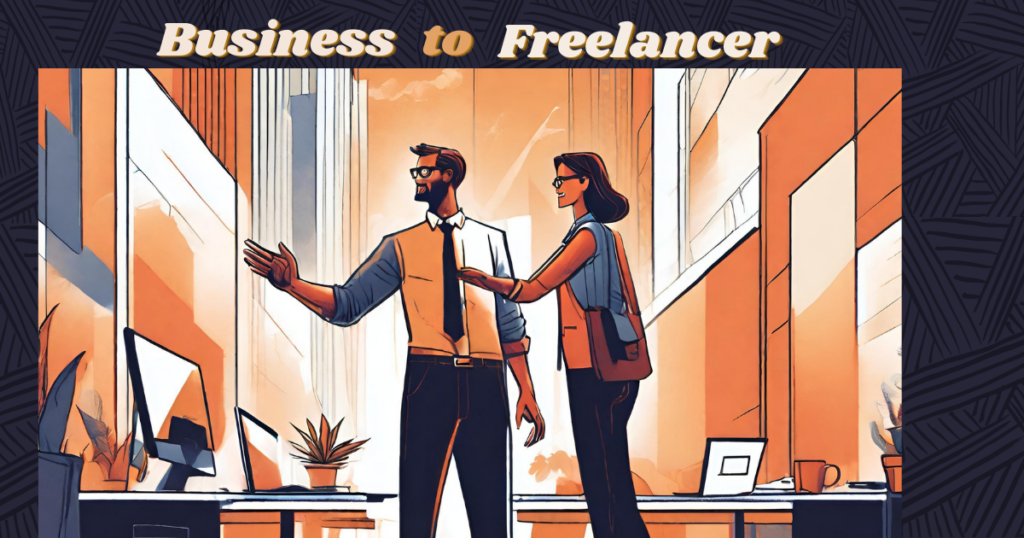
New trends are a dime a dozen these days, but there is one that has been largely ignored while growing at a rapid rate. B2F or Business to Freelancer has been emerging as a redefining factor for how businesses interact with freelancers.
The freelancer community is growing; it is growing fast and quickly proving to be an indispensable part of the modern world. A large-scale survey was conducted in 2021, co-sponsored by Agile Talent Collaborative and the University of Toronto, which found that over 90% of companies depend on freelancers (What We Learned From The Global Survey On Freelancing (forbes.com) ) and have plans to make more use of them in future.
If all you wanted to know was what B2F is, it refers to companies offering specific products, services, or prices to those in the online freelance community.
For those who want more details and some examples feel free to read on.
Business to Freelancer (B2F) Explained
B2F signifies a paradigm shift that has been solidifying over the last decade. It’s nothing new, but companies are approaching and engaging with freelancers now more than ever, and when we look at the classic examples of B2B (Business to Business) and B2C (Business to Consumer) models, the interaction between the businesses and freelancers, just don’t seem to fall under either of the old guard. This has led to companies increasingly recognizing that freelancers are a distinct category of partnership, which demands a new type of approach.
This missing link is what we call the Business to Freelancer (B2F) model and serves to define how business is conducted in the freelance world.
Examples of B2F in Action
Let’s look at some examples of companies that offer services that help push the B2F (Business to Freelancer) model throughout different online sectors. Sure, not all of these businesses necessarily had the freelancing community in mind at the outset, but they all helped to forward the cause.
B2F Job Sites
B2F Job Sites serve as a marketplace where freelancers find most of their online gigs and where individuals/businesses go to find the right freelancer for the job. Sites like Upwork, Freelancer, and Fiverr, play an integral role in making freelancing a sustainable option for professionals who seek a more flexible schedule or are looking for an additional income stream.
Getting Paid
A common concern for freelancers is the dreaded completion of a job and not getting paid for it. Often for smaller gigs there are no formal contracts set up between the freelancer and client, which gives the freelancer little leverage if the client bridges the agreement. This is another benefit of using job sites where they secure payments and act as a mediator in case of any disputes between clients and freelancers. The growth of online payment systems, in general, has propelled freelancing several steps further, with the likes of PayPal and neobanks like Wise offering online bank accounts perfectly complementing the freelancing community and those going all the way to the digital nomad level. Along with these, crypto has also played a part in furthering the online payment landscape, and many people gladly accept this digital dosh as a payment for services rendered.
Specifically for B2F
Some companies have even started to focus solely on freelancers. One example is TripitEasy, a platform that has created an easy-to-use solution for travel content creators looking to monetize their travel content with maps and guides. It is estimated that there are currently over 1.1 billion freelancers worldwide with this figure growing each year; which means that we are bound to see more solutions-based companies popping up in the near future fully focused on the freelancer market.
Special Offers
Another place where we see this B2F-like model appearing is with certain companies offering special deals for freelancers. This comes in the form of individual subscriptions to professional software tools as opposed to team subscriptions that usually add 30% to the price. Some examples of these offers include Adobe Creative Cloud for producing visual content, Microsoft 365 Personal for your productivity tools, Evernote to stay organized, and so many more.
The Freelancer Revolution is Here
From the massive influx of digital nomad visas being offered these days to the rapid growth of people working from home and those looking to utilize their skills in a side hustle to make some extra money, the freelance revolution is in full swing. Within this realm, B2F represents a shift in how companies engage with this new generation of freelancers, going out of their way to offer tailored services and special offers to cater to their unique needs.
For more industry terms that relate to travel creation, check out our article Unlocking the Language of Travel Content Creation: Must-Know Definitions for some insights.
